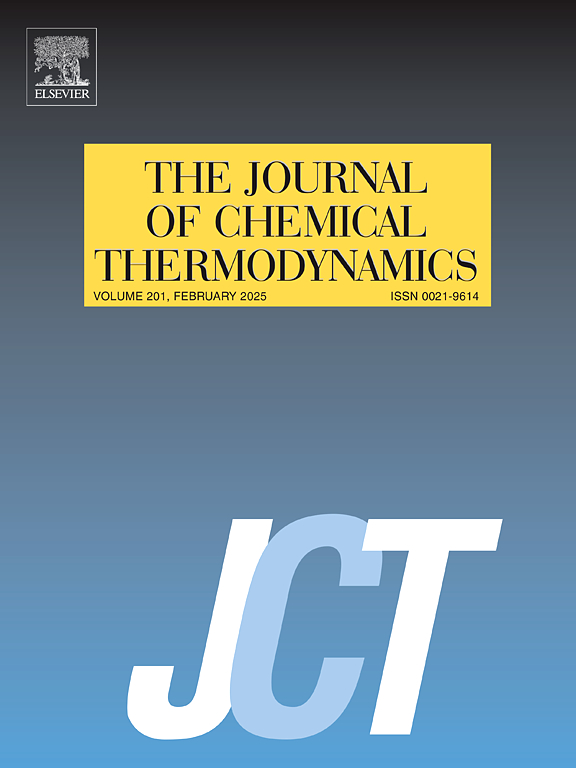Investigation of thermophysical properties and CO2 equilibrium solubility in nonaqueous mixtures of monoethanolamine (MEA) and N,N-dimethylformamide (DMF)
IF 2.2
3区 工程技术
Q3 CHEMISTRY, PHYSICAL
引用次数: 0
Abstract
To reduce CO2 emissions and address issues with conventional amine-based aqueous absorbents, a mixed nonaqueous solution of monoethanolamine (MEA) and N,N-dimethylformamide (DMF) was proposed. The density, dynamic viscosity and refractive index of fresh MEA-DMF solutions (10-50 wt% MEA) and CO2-loaded solutions (0.10–0.51 mol CO2·(mol MEA)−1) were measured across the temperature range of 298.15–333.15 K. The values for fresh solutions were correlated with concentration and temperature using the Jouyban-Acree model (JAM) and an exponential equation. Then the results after CO2 absorption were derived from the CO2 loading amount. Additionally, CO2 absorption performance of MEA-DMF with various concentrations at 303.15–333.15 K and 9.64–134.52 kPa was assessed to determine gas-liquid equilibrium and develop semi-empirical correlations. Nuclear magnetic resonance (NMR) analysis confirmed that carbamate was the primary product formed after CO2 absorption in the nonaqueous absorbent. These studies provide essential data for equipment design and absorbent optimization. MEA-DMF solutions demonstrate favorable viscosity and CO2 absorption performance, supporting the potential use of nonaqueous absorbents in industrial CO2 capture technologies.
单乙醇胺(MEA)和N,N-二甲基甲酰胺(DMF)非水混合物中热物理性质和CO2平衡溶解度的研究
为了减少二氧化碳排放和解决传统胺基水吸附剂的问题,提出了一种单乙醇胺(MEA)和N,N-二甲基甲酰胺(DMF)的混合非水溶液。在298.15-333.15 K的温度范围内,测量了新鲜MEA- dmf溶液(10-50 wt% MEA)和CO2负载溶液(0.10-0.51 mol CO2·(mol MEA)−1)的密度、动态粘度和折射率。利用Jouyban-Acree模型(JAM)和指数方程对新鲜溶液的值与浓度和温度进行了相关性分析。然后根据CO2的负荷量得出CO2吸收后的结果。此外,在303.15 ~ 333.15 K和9.64 ~ 134.52 kPa的不同浓度条件下,对MEA-DMF的CO2吸收性能进行了评估,以确定气液平衡并建立半经验相关性。核磁共振(NMR)分析证实,氨基甲酸酯是在非水吸收剂中吸收CO2后形成的主要产物。这些研究为设备设计和吸收剂优化提供了必要的数据。MEA-DMF溶液具有良好的粘度和二氧化碳吸收性能,支持非水吸收剂在工业二氧化碳捕集技术中的潜在应用。
本文章由计算机程序翻译,如有差异,请以英文原文为准。
求助全文
约1分钟内获得全文
求助全文
来源期刊

Journal of Chemical Thermodynamics
工程技术-热力学
CiteScore
5.60
自引率
15.40%
发文量
199
审稿时长
79 days
期刊介绍:
The Journal of Chemical Thermodynamics exists primarily for dissemination of significant new knowledge in experimental equilibrium thermodynamics and transport properties of chemical systems. The defining attributes of The Journal are the quality and relevance of the papers published.
The Journal publishes work relating to gases, liquids, solids, polymers, mixtures, solutions and interfaces. Studies on systems with variability, such as biological or bio-based materials, gas hydrates, among others, will also be considered provided these are well characterized and reproducible where possible. Experimental methods should be described in sufficient detail to allow critical assessment of the accuracy claimed.
Authors are encouraged to provide physical or chemical interpretations of the results. Articles can contain modelling sections providing representations of data or molecular insights into the properties or transformations studied. Theoretical papers on chemical thermodynamics using molecular theory or modelling are also considered.
The Journal welcomes review articles in the field of chemical thermodynamics but prospective authors should first consult one of the Editors concerning the suitability of the proposed review.
Contributions of a routine nature or reporting on uncharacterised materials are not accepted.
 求助内容:
求助内容: 应助结果提醒方式:
应助结果提醒方式:


